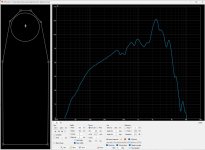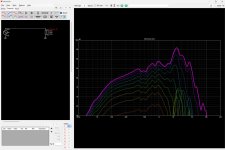NC535 has a dipole thread going, and I don't want to hijack it, so I'm going to take a stab at reverse engineering the Emerald Physics 2.3 here
I've heard a few of the Emerald Physics speakers and was always pleasantly surprised
I heard the "Spatial" speakers (same engineer, Clayton Shaw) and those really blew me away.
So here goes...
To start off, i wrote this on NC535's thread:
"
Looks like Clayton Shaw went down the same path that NC535 is going:


The CS2 was a fairly conventional dipole


The CS2.3 is basically a different loudspeaker. Waveguide tweeter is replaced with a high efficiency coax, and the coupling chambers on the woofers is unique


Their naming conventions are awful, because this is also a "CS2.3." But every last driver is different, the DSP has changed from Behringer to a miniDSP, and it introduces the triangular-ish baffle that NC535 is evaluating. In the phone online, one of them has a crack in it, and it looks like it's constructed like a surfboard, so that's new too. (Foam on the inside, wood or fiberglass on the outside, with a gel coat.)
I've heard a few of the Emerald Physics speakers and was always pleasantly surprised
I heard the "Spatial" speakers (same engineer, Clayton Shaw) and those really blew me away.
So here goes...
To start off, i wrote this on NC535's thread:
"
Models are not 100% accurate. I am not sure what type of model is used in VituixCAD. I just use them as a rough guide, then I have to buy, build, and measure to know what is really going on.
There is a speaker by Emerald Physics that got good reviews when it was produced. You might find some inspiration in the design:
https://www.theabsolutesound.com/articles/emerald-physics-cs23-mk-ii-loudspeaker/
Some pics showing the driver layout, etc. can be found here:
https://tmraudio.com/old-products/emerald-physics-cs2-3-open-baffle-speakers-excellent-pair-cs-2-3/
To manage floor bounce I use the Allison approach: put the woofer right at floor level, as low as possible. Cross over as high as 300Hz to the midrange, which should be as high as possible (like the coax on top placement). This gives the woofer the most floor gain to the highest frequency possible, and the midrange has the least amount of floor bounce effects.
Looks like Clayton Shaw went down the same path that NC535 is going:


The CS2 was a fairly conventional dipole


The CS2.3 is basically a different loudspeaker. Waveguide tweeter is replaced with a high efficiency coax, and the coupling chambers on the woofers is unique


Their naming conventions are awful, because this is also a "CS2.3." But every last driver is different, the DSP has changed from Behringer to a miniDSP, and it introduces the triangular-ish baffle that NC535 is evaluating. In the phone online, one of them has a crack in it, and it looks like it's constructed like a surfboard, so that's new too. (Foam on the inside, wood or fiberglass on the outside, with a gel coat.)
Inspired by these CS2.3, I have built a speaker with a dipole woofer and a big horn. It sounded OK but something was off. Adding a second, rear facing horn, fixed the issue and made the sound much more natural. Alternatively, removing the 2nd horn and enclosing the woofer in a closed box also worked. Therefore I think that the directivity mismatch at 1 kHz is a problem.
It adds mass to the cone, which lowers fs and sensitivity, while increasing Qts. It might also increase the dipole spacing, though I am not sure about that.and the coupling chambers on the woofers is unique
Last edited:
Are these being sold with or without dsp?
I just copied the pictures, the speakers are sold
Attached is a sim of the midbass from the Emerald Physics speaker (the newer one, that's triangular-ish)
Here's some things I notice:
- It's kinda amazing the bandwidth that it maintains directivity control
- I thought a twelve inch prosound driver was overkill for a home speaker, but I didn't really grasp how much SPL you lose with such a narrow baffle. I've built dipoles before, but generally used wider baffles. At 500Hz, the output level is down 10dB compared to an infinite baffle.
- It needs to be crossed over by 1000Hz or so, because it begins to beam, due to the diameter of the radiator
For this sim, I used the Dayton PCX12-8 instead of what Emerald Acoustics uses (which appears to be Eminence in the first Emerald Physics CS2.3, unknown in the second CS2.3)
Here's some things I notice:
- It's kinda amazing the bandwidth that it maintains directivity control
- I thought a twelve inch prosound driver was overkill for a home speaker, but I didn't really grasp how much SPL you lose with such a narrow baffle. I've built dipoles before, but generally used wider baffles. At 500Hz, the output level is down 10dB compared to an infinite baffle.
- It needs to be crossed over by 1000Hz or so, because it begins to beam, due to the diameter of the radiator
For this sim, I used the Dayton PCX12-8 instead of what Emerald Acoustics uses (which appears to be Eminence in the first Emerald Physics CS2.3, unknown in the second CS2.3)
Attachments
Beaming to the point of being destructive to consistent directivity won’t be an issue til around 1.4khz and the absent dustcap is where a typical woofer does most of its beaming…….and if i as a designer were faithfully relying on the cone to act as the most stable waveguide possible, I’d say the minimum high pass would be around 500hz……more of a filler driver application than a midrange.
They most likely moved in this direction toward coax from the disappointing performance of that round waveguide used in the earlier design…..that thing is god aweful from the profile to the terrible flimsy construction and resonance.
A large dipole AMT is the path fwd here for these designs…..and for those that complain about vertical directivity, well…..take a seat…….that’s how music is truly enjoyed.
They most likely moved in this direction toward coax from the disappointing performance of that round waveguide used in the earlier design…..that thing is god aweful from the profile to the terrible flimsy construction and resonance.
A large dipole AMT is the path fwd here for these designs…..and for those that complain about vertical directivity, well…..take a seat…….that’s how music is truly enjoyed.
I just copied the pictures, the speakers are sold
I was asking if emerald phtsics is selling speaker just with passive crossover.
This is what you wrote:
"But every last driver is different, the DSP has changed from Behringer to a miniDSP, and it introduces..."
So my question was: where is dsp from? You? Emerald Physics? Who changed it? You? Emerald Physics?
Whats up with dsp?
The first Emerald Physics CS2.3 used a Behringer DSP, the second one used a MiniDSP
As I understand it, the company was sold, and when it was sold they changed the drivers and the DSP, though the speaker name is the same
Clayton Shaw (the CS in CS2.3) formed a new company called "Spatial Audio" that made passive dipoles
As I understand it, the company was sold, and when it was sold they changed the drivers and the DSP, though the speaker name is the same
Clayton Shaw (the CS in CS2.3) formed a new company called "Spatial Audio" that made passive dipoles
- Home
- Loudspeakers
- Multi-Way
- Reverse Engineering Emerald Physics

